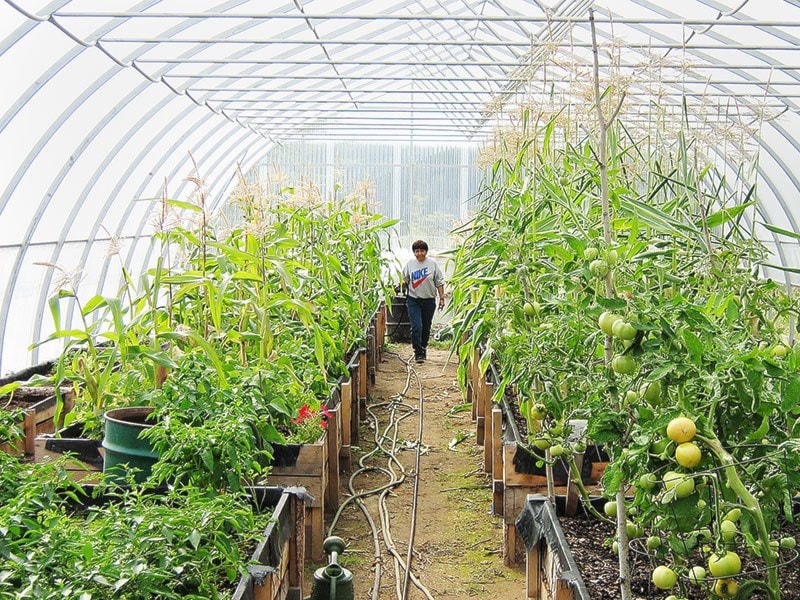Miche Genest
Special to the News
In its recently released local food strategy, the Yukon government’s agricultural branch calls backyard and community gardens “an important part of food sovereignty and sustainable local food production,” and lays out a strategy for supporting those gardens.
Already, the branch encourages the development of farmers markets, First Nation and community gardens and greenhouses with start-up funding and training. For backyard gardeners, the branch will set up an online link for sharing tools and supplies, finding compost, and learning where plots of idle land suitable for gardening are located.
But community gardens and greenhouses are also a form of grassroots support — they often end up becoming informal resource centres for backyard gardeners. Alice Boland, who has been with the Little Salmon Carmacks Greenhouse and Farm Operations project since it started in 2000-2001, says as people become more interested in eating healthily, she is seeing more backyard gardens in Carmacks. “A lot of people are starting to grow vegetables. They come to see me for advice, and I go out and help them whenever I can.”
When the greenhouse project started up, Boland attended Yukon College’s master gardening course. She trained at Yukon Gardens in Whitehorse, at Kathy Kruse’s garden in Mayo, and she learned on the job, first under the supervision of Chris Gall, and then as supervisor herself.
“You never stop learning,” she says. “You learn new things, new plants. This job never gets boring, there’s always something different.”
The greenhouse started small but is now 45 metres long and 12 metres wide. Here Boland and her crew grow everything from corn, melons and pumpkins to carrots, beans and kale, peas, cabbage, cauliflower, broccoli and other cold-hardy vegetables grow outside, and there’s a potato field across the river. The project also includes cold storage facilities for root vegetables.
Boland stresses that the Little Salmon-Carmacks greenhouse isn’t a community garden in the sense that people come in and garden themselves. “We grow it for the people,” she says. Food is distributed for free to community members with diabetes or on a lower income, and Boland encourages kids to come into the greenhouse, see what’s growing, and have a snack. The kids call her “Aunty Alice.”
The school bus stops right in front of the greenhouse and Aunty Alice calls them over. “I give them carrots, and tomatoes, some cucumber or zucchini or lettuce — they love lettuce — and you know, they’re so happy.”
Kids are at the centre of Kluane First Nation’s brand-new community garden and greenhouse in Burwash Landing, too.
“It isn’t a community garden yet,” says co-ordinator Sandy Johnson. “What we have at this point is a greenhouse and a tiny little garden that I do with daycare and day camps in the summer.” There is a vision for a larger greenhouse, with vertical planting and hydroponics, and perhaps a revenue-generating scheme so the green house is more sustainable, but plans are on hold until the First Nation works out the kinks with geothermal heating from a warm spring.
In the meantime, Johnson and her kids grow vegetables in the 2.5 metre feet by three metre greenhouse and in the garden. They’ve got kale and marigolds in planters in front of the rec centre — the recreation board paid for the planters, and said the kids could grow vegetables as long as they grew flowers too.
Getting kids into the garden this young, “plants a seed” Johnson says. “I always tell people we’re growing gardeners. This year daycare started all of their own seeds, and looked after them in the window of the daycare.” Now the kids water their plants faithfully, even the two-year olds. “They can handle a watering can,” says Johnson.
She has been teaching the kids how to cook, so that they use the produce that they’re growing. “We’ve done kale chips and wonton soup and stuff like that — cause a lot of [kids] don’t always get to taste those kinds of things.”
There’s no grocery store in Burwash, though is there a small convenience store in nearby Destruction Bay. Fresh produce is scare, and to stock up, community members have to drive to Whitehorse, a six-hour round trip. Johnson says the community sees the benefit of the greenhouse. “The kids get to take cucumbers and tomatoes home, and lettuce. The leftover produce goes to the First Nation office and people come and get some if they want it.”
As a community, Burwash Landing is historically familiar with gardening. “People were introduced to growing things very early here. The Dickson family had a homestead at the mouth of the Kluane River, and had a huge garden down there.” Louis and Eugene Jacquot, too, had a big garden near the beginning of the 19th century. In a 2006 interview with Daniel Tlen, elder Jimmy “Copper” Joe recalled, “[The Jacquots] showed our people how to put in a big garden and everybody worked in that big garden and shared what they grew.”
But the First Nations experience of gardening and farming in the Yukon was not always a happy one. Many First Nations people remember being forced to work in the school garden at residential schools. For them, working in their own community garden has become a way of healing past wounds.
Gardening initiatives can contribute to a community’s health and wellness but the development of greenhouses and field vegetables can also lead to an increase in the scale of local food production. To follow this growing trend, next week’s article will highlight new farming and agriculture programs on First Nations territories.
This article is part of a series commissioned by the Yukon Agricultural Association and funded by Growing Forward 2, an initiative of the governments of Canada and Yukon.
